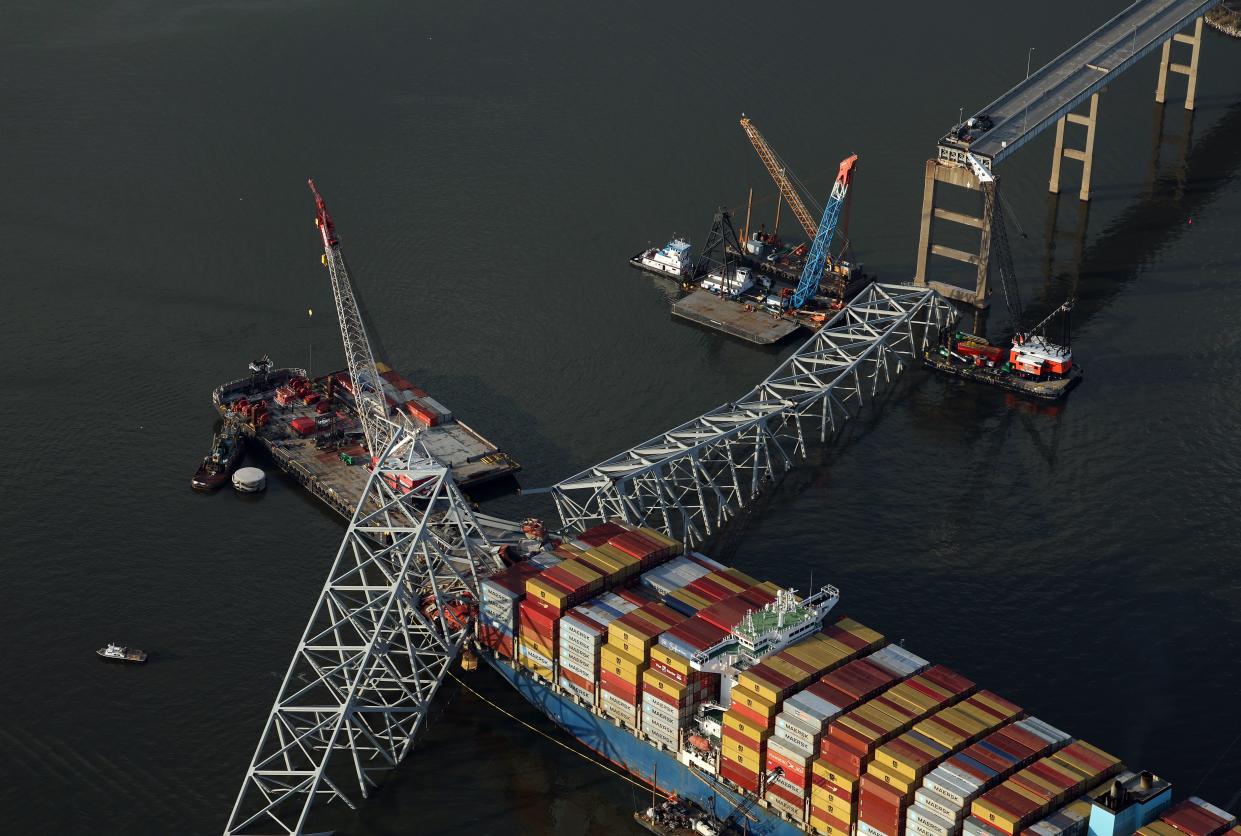Baltimore's Black mayor and the city were scrutinized nationally after bridge collapse.

- Oops!Something went wrong.Please try again later.
Editor's Note: This column was updated to correct that Brandon Scott is not the first Black mayor of Baltimore.
When the Francis Scott Key Bridge was hit by a ship in the heart of Baltimore, no one had been expecting such devastating wreckage. The bridge played a crucial role in connecting the lives of thousands of civilians in the neighboring area, and now it lay crumbled in the cold Patapsco River.
Yet, in the midst of recovery and cleanup efforts, the criticism has turned not to the decades-old construction or the lack of collision-prevention structures, but rather toward the mayor of Baltimore, Brandon Scott. The discriminatory comments being made toward Scott on the basis of race are disheartening to see, especially in a city in which a massive accident has just occurred.
On that cold March 26 morning, the ship Dali lost power unexpectedly. The ship and its 22 mariners, all from India, were on a long trek to Sri Lanka and were transporting massive bulks of cargo. However, on its journey out of the Port of Baltimore, the Dali suddenly shut down and had a complete outage of power, rendering every control, engine and signal useless.
In a last-minute desperation call, the Dali was able to signal to traffic coordinators that their ship was a runaway, in moments about to slam into the Francis Scott Key Bridge. Due to this warning, many lives were saved by traffic control preventing civilians from getting on the bridge. However, a late-night construction crew (many of whom were immigrants from Latin America) were notified too late. Despite the best efforts from the crew, who immediately dropped the anchor in the midst of a chaotic 5-minute power sequence, the city-block-length vessel crashed into the central form of the structure. Moments later, to the horror of those watching, the vast majority of the bridge soon followed, toppling into the dark, murky waters of the river below.
In the center of such a period of uncertainty is Baltimore's mayor. Scott had already had numerous instances of backlash and derogatory remarks hurled at him. However, the bridge collapse brought Scott and the city of Baltimore under national scrutiny, something that Baltimore did not necessarily need. The aftermath of the collapse has since brought a resurgence of hate toward the mayor, someone who is simply trying to unite a city torn by a devastating tragedy.
More from Alex Seojoon Kim: Sen. Tom Cotton's racist questioning is 'modern-day McCarthyism,' young columnist writes
Troubling statements from a variety of internet pundits are unwarranted and disrespectful to a city still struggling amid decades of internal conflict. With a poverty rate that continues to pose an issue (20.3% in 2021) and thousands of Americans leaving the city in the hopes of finding “greener pastures,” the role of being mayor of Baltimore is no easy feat.
Scott, who was elected mayor in 2020, has since worked tremendously to spur a movement to address certain underinvestment issues that have been plaguing his residents for years. From a purely statistical standpoint, it is tough to find a mayor of Baltimore who has done more things for his city than Scott has done. For instance, unemployment rates are at a record low, from 12.6% in 2020 to 2.3% in 2023, a sign of how Scott’s plans have bettered the community. In addition to economic improvement, Scott has invested a historic amount of money directly to Baltimore’s youths, improving school conditions for over 50 schools while offering employment/community involvement activities, as well. Crime rates also have had a staggering drop-off, with homicide rates down 20%, making it the lowest in nearly a decade. Despite these accolades and accomplishments, why is Scott always under the racial scrutiny of the internet?
More: Young perspective: Despite the 'end' of affirmative action, diversity must prevail
As Scott sported a varsity “City of Baltimore” jacket and talked with reporters about the bridge tragedy, social media blew up, not with messages of support and encouragement for those still missing, but about Scott’s race and suitableness as a leader. Some conservatives are criticizing Diversity, Equity and Inclusion (DEI) acts as ploys to get minorities more job opportunities instead of "more qualified" white candidates. However, the irony lies in how Scott got his position as mayor of Baltimore. As a Black man, Scott was not handed the mayorship, but was duly elected by voters, securing about 70% of the vote.
The double standard viewpoint is not only disrespectful to a man who is trying to support Baltimore but discouraging to the essence of unity to the city.
The Francis Scott Key Bridge collapse highlighted the desperate need for investment in the struggling infrastructure industry, as well as the demoralizing prejudices that break down societal harmony. Americans must remember to strive for compassion and integration in the face of hardship so the nation can bloom beautifully.

Alex Seojoon Kim is a high school student in Stillwater.
This article originally appeared on Oklahoman: Baltimore bridge collapse brings hate to city's Black mayor

